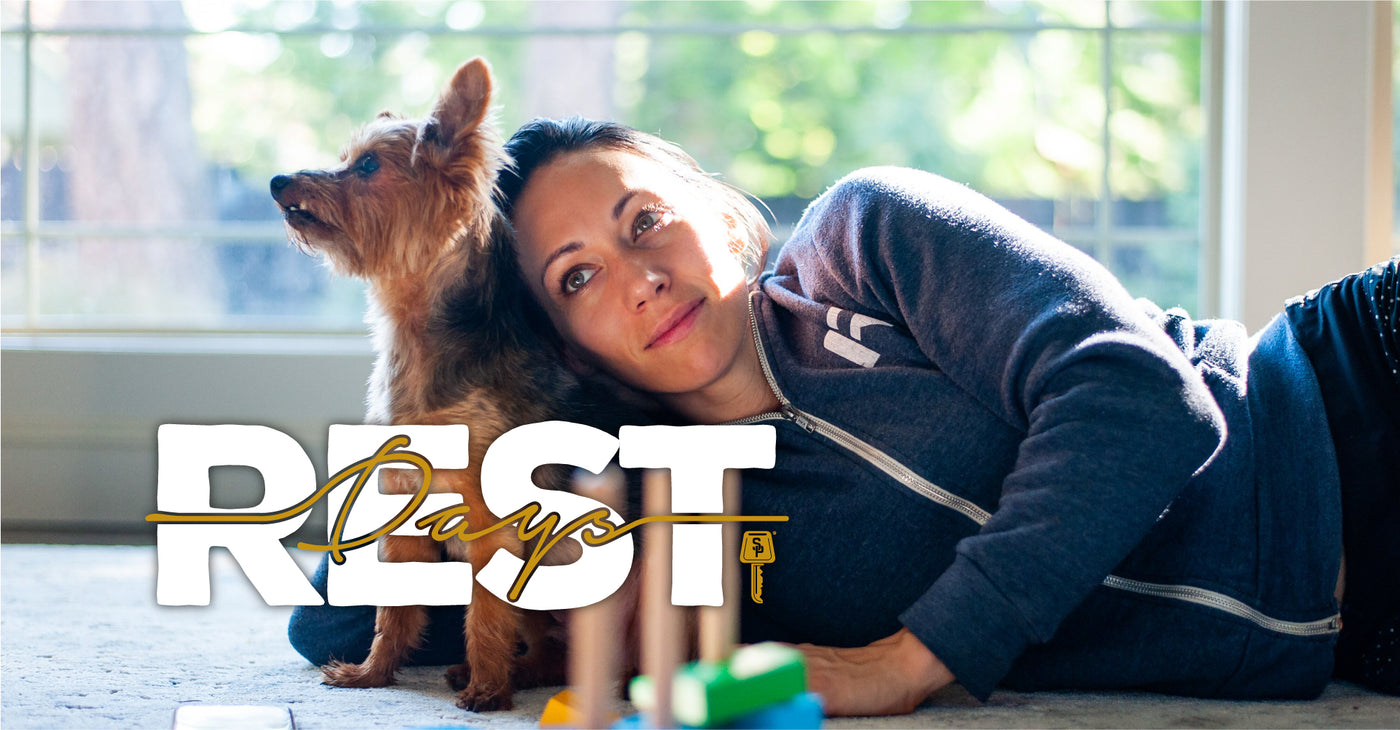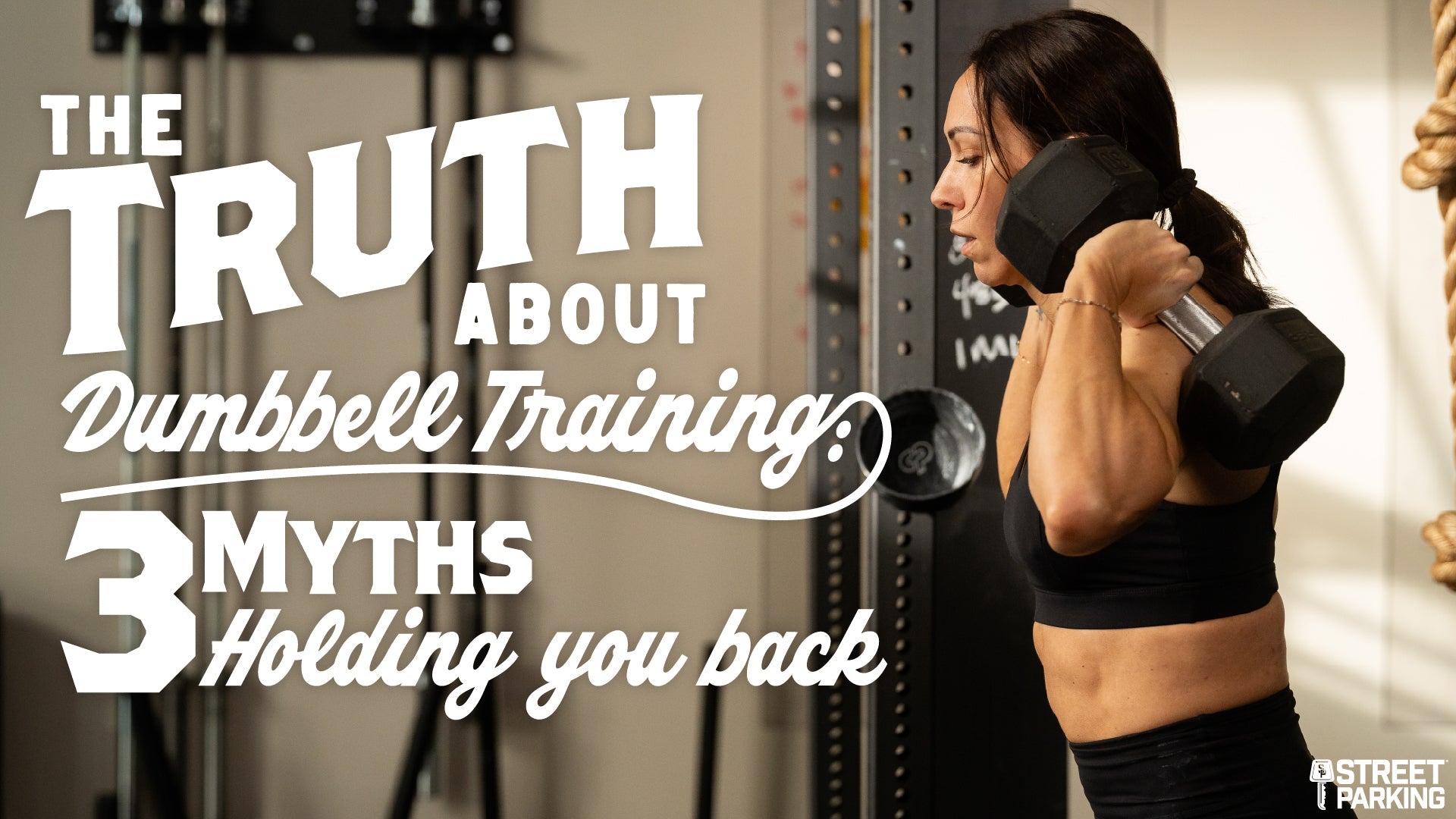
Rest days.
- When are you supposed to take one?
- How do you know when you’re supposed to take one?
- Are you currently taking too many? Too little?
We know that the concept of “rest day” can be a taboo subject so we decided to survey our private Facebook group of over (17k) members and asked them how many rest days they took per week.
An Unsuccessful Approach to Rest Days
The most common answers from the group were:
- Whenever I want
- 2 days a week
- 1 day a week
Here’s what’s challenging about these answers and here are some patterns we want you to keep an eye out for within your own fitness routine.
-Let’s say you don’t necessarily LOVE working out. “Whenever you want" can easily become your excuse for skipping a workout….and then 2….and 3…..and so on…..
Example: You’ve had a long day at work, traffic was terrible, you get home and take off your shoes, a new episode of your favorite show is on TV, and….. you’re tired. “Well I’m really tired so I think I need a rest day.” You didn’t actually need a rest day. You just wanted one.
-Let’s say you are a very structured individual who loves keeping to a schedule, so you allow yourself to have a rest day on Tuesday and Thursday. It’s a great plan until…..
Example #1: You do a workout and when you wake up on Wednesday you are absolutely wrecked. Your body is telling you that today would be a great day for a rest day but yours isn’t scheduled until Thursday. This may lead you to skip a rest day when you really needed it.
Example #2: Friday is a scheduled workout day but on this particular Friday, you get a call from your kid’s school saying you need to come pick them up because they’re sick. This completely throws your day off and you spiral into a panic. You needed to workout today and now you can’t.
The Goal
As you progress with your fitness routine, the ultimate goal is to develop self awareness, which will help you assess YOUR rest day needs and better determine when to take them and how often.
In the beginning, we know this can come off as overwhelming or difficult to self diagnose because you haven’t gathered enough data to really understand yourself in this space yet, so let us help lift that burden off of you by:
- Walking you through a few simple formulas and helping you pick one to test out
- Reminding you that with time and consistency, this self awareness process will become simple, just like driving a car did one year after getting your drivers license. Trust us. We’ve been in your shoes.
Different Types of Movement
As always, our main focus for everyone is consistency, as consistency is the key to accomplishing small daily disciplines that will compound into long lasting results.
However…consistency does NOT necessarily equal high intensity every single day. Consistency in movement can show itself in a few different ways, so let’s take a look at the 4 different types of consistency as it pertains to movement:
The 4 types of movement:
1. High Intensity Days
These are the days where you’re really going to push yourself to your performance limits, whether that’s picking up your pace or going heavier. You’re going to give the workout everything you’ve got and leave nothing behind on high intensity days
2. Workout Days
On workout days your goal is to get the work done. Don’t slack off, but you don’t need to push it like you do on the high intensity days. Focus on movement and form, work up a nice sweat, and be done for the day
3. Moving Days
Moving days aren’t considered workout days. On these days you are going on a walk, bike ride, hike, casual row or swim, playing soccer at the beach with friends, etc. Moving days are designed for leisure and fun
4. Rest days
Raise your hand if you’re all about Netflix and chilling! Rest days are for resting. Stay away from the gym. Watch a movie — or two. These days are designed to give you a physical and psychological break
Now that we know consistency can show itself in different forms, let’s help you best determine which stage you’re currently in and what your movement should ideally look like on a weekly basis.
Keep in mind that stages are going to vary from someone who just started working out to someone who has been consistent with their training and nutrition for an extended period of time.
Determining What Stage You’re Currently In
STAGE 1: Someone who is new to working out, dealing with an injury, recovering from being seriously ill, postpartum mothers, etc.

WEEKLY BREAK DOWN
3 Workout Days
2 Moving Days
2 Rest Days
0 High Intensity Days
Note: If you’re brand new to working out, we're not expecting you to jump to 7 days of movement right off the bat. It’s not realistic and we’d be setting you up for failure because it’s not sustainable longterm.
Example:
- Do Program A for 3/3 of your workout days. Don’t worry about the clock. Just get through the workout
- For your 2 moving days go on a long walk, jump on the bike, play with your kid at the park, etc.
- For your 2 rest days, don’t do anything! Netflix and chill, get some sun by the pool
*This stage should last 4-8 weeks
STAGE 2: Someone who’s been consistent with Stage 1 movement for 4-8 weeks

WEEKLY BREAK DOWN
4 Workout Days (1-2 of which should be made into High Intensity days)
2 Moving Days
1 Rest Day
Example:
- Do Program A for 2/4 of your workout days. Push it for intensity on these 2 days
- Do Suns Out Guns Out for 1/4 of your workout days. The goal is to get through the work
- Do Butts and Guts for 1/4 of your workout days. The goal is to get through the work
- For your 2 moving days go on a long walk with a friend, take a bike ride, do SP maintenance, etc.
- For your 1 rest day, don’t do anything. Watch a movie. Netflix and chill. Sit by the pool
STAGE 3: This is the ideal place for everyone to live! It’s realistic, sustainable, won’t wreck you, and you’ll see great results.

WEEKLY BREAK DOWN
4 Workout days (3-4 of which should be made into High Intensity Days)
2 Moving Days
1 Rest Day
This is basically the same as the Stage 2 breakdown but with 1-2 additional high intensity days.
STAGE 4: The people who love working out so much that they constantly want to push it and are in a season of life where they have the time to do just that

WEEKLY BREAK DOWN
5 Workout days (3-4 of which should be made into High Intensity Days)
2 Moving days
0 Rest days
This only works/you’ll only see quality results in this stage if your recovery practices (sleep, nutrition, etc) are dialed in, and if your overall life stressors are low.
This stage gives you ONE more workout day but your high intensity days stay the same as Stage 3. We DON'T recommend more than that for almost anyone.
Picking a Stage and Putting it to the Test
Once you’ve picked the stage that you feel best represents your current situation, we want you to test that stage out for 2-4 weeks. Then we will diagnose your choice.
A couple of tips:
- If you haven’t been training with any level of consistency for 3 months or more, we suggest starting with stage #1 and staying there for a minimum of 3-4 weeks to allow your body to adjust to the change.
- If you have been training but need to transition to a different stage that seems more appropriate for you during this season of life, we suggest sticking with it for a minimum of 2 week, but 3-4 weeks is even better — before you decide if it’s the right stage for you at this time.
How to Diagnose Whether or Not You Picked the Right Stage
You may have picked the correct stage if:
-On high intensity workout days, your scores are getting better on retest days
-You’re able to use more weight and not be wrecked for several days after
-You’re sore, but in a way where going through a proper warmup the next day is sufficient for getting you ready for the next day’s workout
-You’re feeling good during AND outside of workout time
You may have picked the incorrect stage if:
-You feel sluggish and demotivated
-Your scores aren’t getting better
-The weights feel heavier than normal
-You’re not sore at all and don’t feel like you’re doing enough
-You have no desire to follow through with any level of intensity
Main Takeaway:
If you picked a stage and are feeling good, stick with this stage until something changes that might urge you to move up or down. We need to start recognizing that our lives are going to have highs and lows of their own and we need to be prepared to move around the different stages accordingly.
If you get really busy with work or parenting roles, take an extended trip, become pregnant, go through a postpartum period, etc, consider taking it down a notch and choosing a stage that allows you to maintain consistency.
On the flip side, if you’ve been sticking to a certain stage for a few months and feel like you could do more without burning yourself out, interrupting your personal goals outside of the gym, or have a new and specific goal to train for — you might be ready to move up to the next stage.
Now, if you’re currently drained, demotivated and have no desire to follow through, do NOT stick with your current stage. Back off a bit and find consistency in a less intense stage. Remember, consistency is always going to be the #1 ingredient for long lasting change and results.
The Hidden Choices That Make All the Difference
So far we’ve only discussed your movement — how often to move and what kind of movement you should do.
Let’s briefly talk about your movements team members:
-Quality Sleep
-Proper Nutrition
-Less Stress
You have to start thinking of these subjects as a team, as they really don’t work efficiently on their own, and quality results are going to be a byproduct of paying attention to the entire team.
1. Proper Nutrition
When your nutrition is quality and consistent, your body is able to recover faster, which results in less rest days needed. When your nutrition is crappy and inconsistent, it will eventually lead to you needing more rest days and/or you won’t need more rest days but your results will be subpar.
2. Quality Sleep
Sleep is just as important as nutrition and exercise when it comes to improving your health, performance and body composition. Quality sleep helps our bodies and minds recover, keeping us lean, happy, mentally focused and healthy. A good goal to aim for is 7+ hours of sleep a night. We know this isn’t always realistic with our busy careers and nightly feedings, but this is another factor to pay attention to if your movement performance feels off.
3. Less Stress
Again, we know that this isn’t always something we can fully control, but it could be another tell tale sign that if our movement performance is off and we currently feel really stressed out, this may be the reason.
If you are currently feeling stressed out, consider implementing a few of these strategies:
-Getting enough sleep
-Having a structured morning and bedtime routine
-Going on consistent, daily walks
-Taking 10 minutes per day with no distractions. Sit in a room by yourself and breathe
Again, we will cover these subjects in detail in a different post, but the goal here is to be aware that your movement, nutrition, sleep, and stress levels all work together as a team.
Recap
- Rest is important for every single one of us, but how much rest we need is NOT a one size fits all answer, as applying context to our individual situation is important
- Rest days need to be strategic, not randomized. Again, applying context to our individual situation
- Determine which stage best fits your current situation and follow that stage’s guidelines for 2-4 weeks
- After following your stage’s guidelines for 2-4 weeks, assess how you’re feeling. If you’re not feeling great, take the other 3 team members into consideration (nutrition, sleep, stress) as potential reasons why. If you know you’ve been neglecting one of those 3 team members, consider focusing on that and staying in your current movement stage
- If your lifestyle shifts, consider backing off to a less intense movement stage and/or leveling up to the next movement stage, depending on what lifestyle changes have taken place


